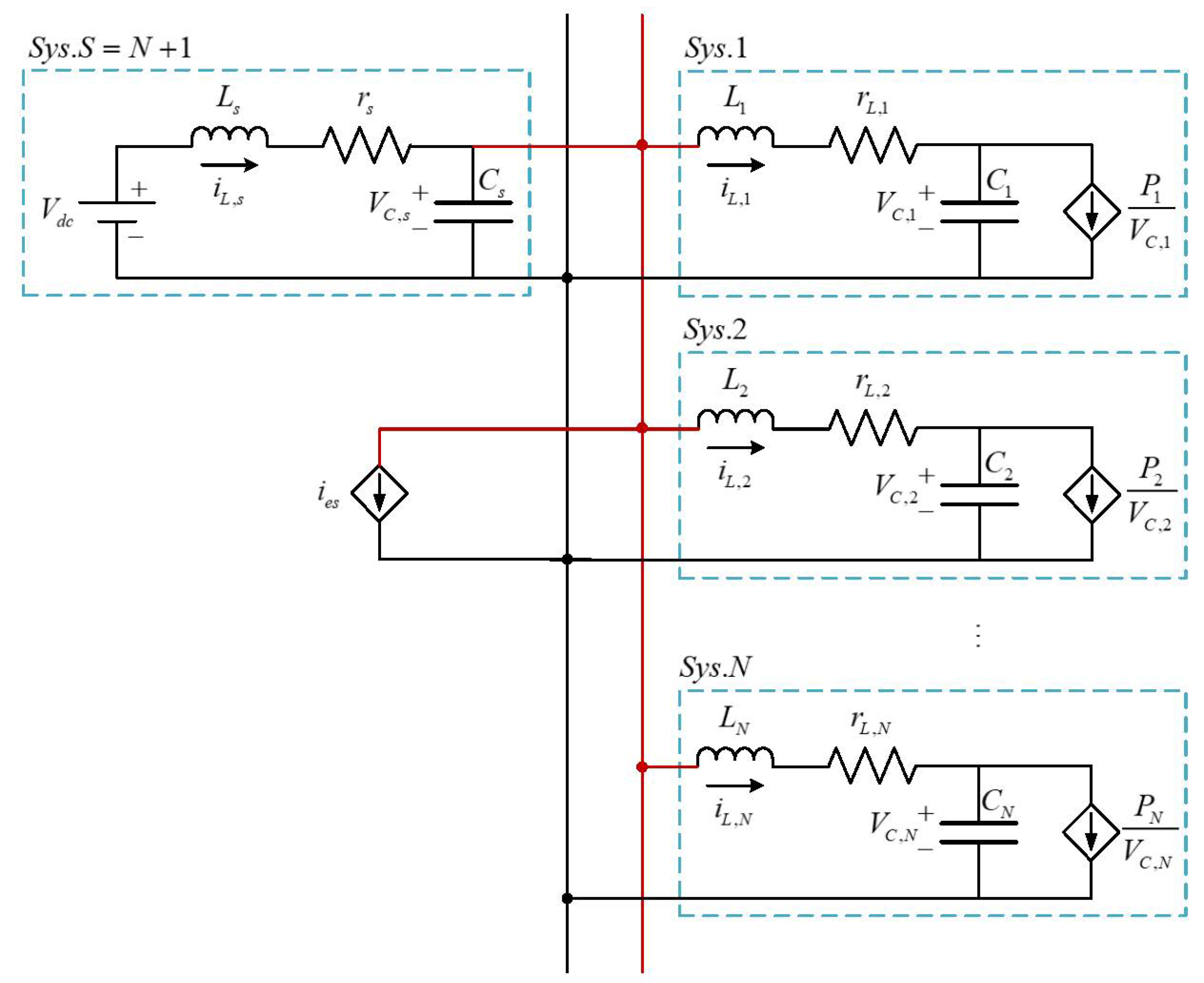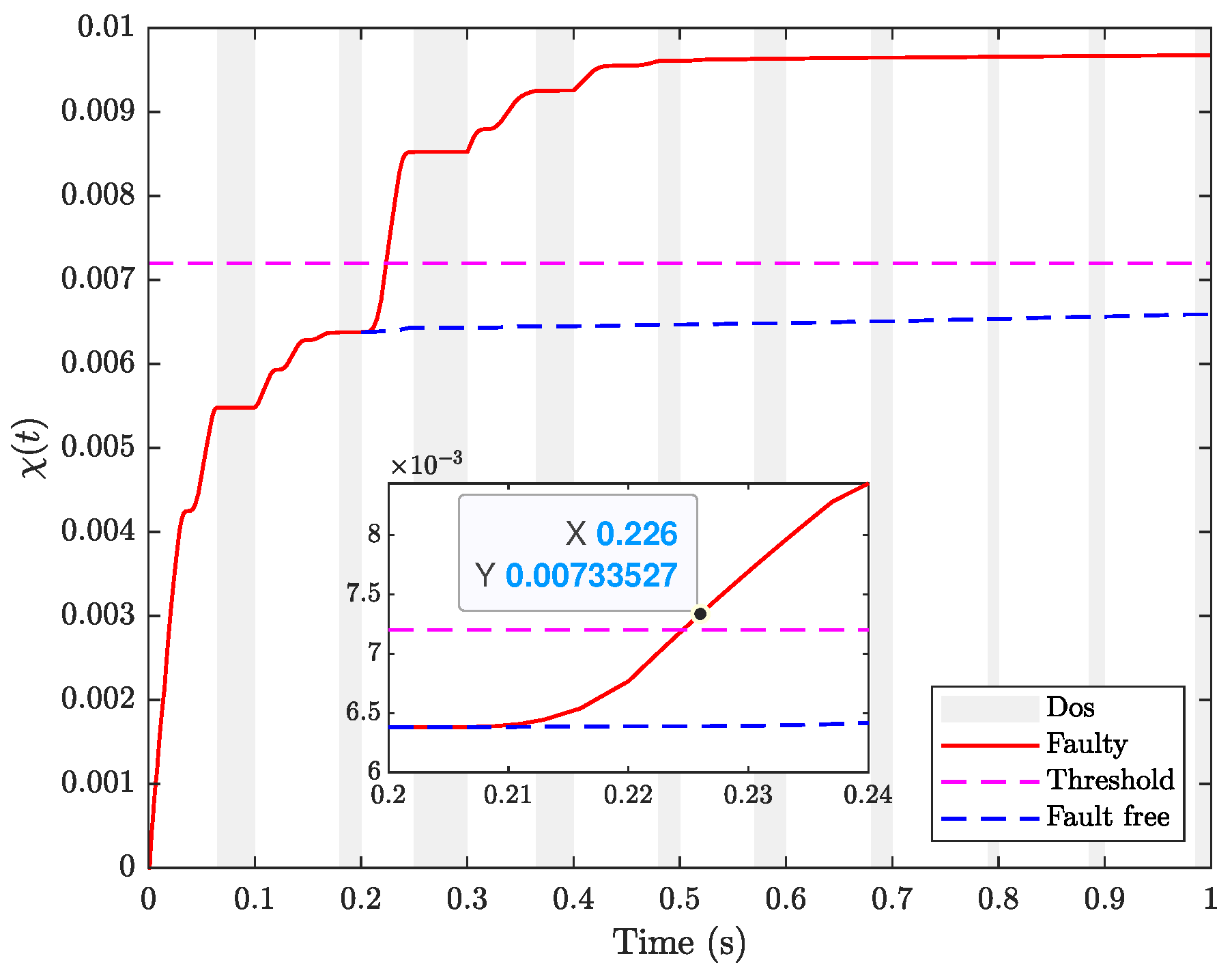Resilient Event-Based Fuzzy Fault Detection for DC Microgrids in Finite-Frequency Domain against DoS Attacks
Abstract
:1. Introduction
- (1)
- A novel integrated ETM is proposed for DC microgrids, under which historical state information is utilized to design the triggering condition. This ETM generates fewer events compared to the traditional event-triggered mechanism (traditional ETM), while ensuring the performance of fault detection for DC microgrids.
- (2)
- An integrated event-triggered fault detection filter (FDF) is designed for DC microgrids under DoS attacks. In contrast to existing fault detection methods for DC microgrids, the frequency band of fault occurrence is considered in the proposed FDF, which reduces the constructiveness of the filter design.
2. Problem Formulation
2.1. System Modeling
- (1)
- = 1, , occurs in the low-frequency band.
- (2)
- = 1, , occurs in the middle-frequency band.
- (3)
- = −1, , occurs in the high-frequency band.
2.2. DoS Attacks and the ETM Design
2.3. T-S Fuzzy Switched Residual System
- 1.
- When , the system (16) achieves exponential stability.
- 2.
- Under zero initial conditions, when , the fault sensitivity conditionholds for all solutions of (16) satisfyingwhere the asterisk * denotes the conjugate transpose.
- 3.
- Under zero initial conditions, when , the system (16) is bounded by
3. Main Results
4. Simulation
5. Conclusions
Author Contributions
Funding
Institutional Review Board Statement
Informed Consent Statement
Data Availability Statement
Conflicts of Interest
References
- Hou, N.; Ding, L.; Gunawardena, P.; Wang, T.; Zhang, Y.; Li, Y.W. A Partial Power Processing Structure Embedding Renewable Energy Source and Energy Storage Element for Islanded DC Microgrid. IEEE Trans. Power Electron. 2022, 38, 4027–4039. [Google Scholar] [CrossRef]
- Al-Ismail, F.S. DC microgrid planning, operation, and control: A comprehensive review. IEEE Access 2021, 9, 36154–36172. [Google Scholar] [CrossRef]
- Dragičević, T.; Lu, X.; Vasquez, J.C.; Guerrero, J.M. DC microgrids—Part I: A review of control strategies and stabilization techniques. IEEE Trans. Power Electron. 2015, 31, 4876–4891. [Google Scholar]
- Liu, J.; Lu, X.; Wang, J. Resilience analysis of DC microgrids under denial of service threats. IEEE Trans. Power Syst. 2019, 34, 3199–3208. [Google Scholar] [CrossRef]
- Herrera, L.; Zhang, W.; Wang, J. Stability analysis and controller design of DC microgrids with constant power loads. IEEE Trans. Smart Grid 2015, 8, 881–888. [Google Scholar]
- Gu, Z.; Fan, Y.; Sun, X.; Xie, X.; Ahn, C.K. Event-based two-step transmission mechanism for the stabilization of networked T-S fuzzy systems with random uncertainties. IEEE Trans. Cybern. 2023, 54, 1283–1293. [Google Scholar] [CrossRef] [PubMed]
- Zhang, J.; Li, S.; Xiang, Z. Adaptive fuzzy output feedback event-triggered control for a class of switched nonlinear systems with sensor failures. IEEE Trans. Circuits Syst. I Regul. Pap. 2020, 67, 5336–5346. [Google Scholar] [CrossRef]
- Chen, H.; Zong, G.; Zhao, X.; Gao, F.; Shi, K. Secure filter design of fuzzy switched CPSs with mismatched modes and application: A multidomain event-triggered strategy. IEEE Trans. Ind. Inform. 2023, 19, 10034–10044. [Google Scholar] [CrossRef]
- Sun, P.; Song, X.; Song, S.; Stojanovic, V. Composite adaptive finite-time fuzzy control for switched nonlinear systems with preassigned performance. Int. J. Adapt. Control Signal Process. 2023, 37, 771–789. [Google Scholar] [CrossRef]
- Yue, S.; Niu, B.; Wang, H.; Zhang, L.; Ahmad, A.M. Hierarchical sliding mode-based adaptive fuzzy control for uncertain switched under-actuated nonlinear systems with input saturation and dead-zone. Robot. Intell. Autom. 2023, 43, 523–536. [Google Scholar] [CrossRef]
- He, H.; Qi, W.; Yan, H.; Cheng, J.; Shi, K. Adaptive fuzzy resilient control for switched systems with state constraints under deception attacks. Inf. Sci. 2023, 621, 596–610. [Google Scholar] [CrossRef]
- He, Y.; Chang, X.H.; Wang, H.; Zhao, X. Command-filtered adaptive fuzzy control for switched MIMO nonlinear systems with unknown dead zones and full state constraints. Int. J. Fuzzy Syst. 2023, 25, 544–560. [Google Scholar] [CrossRef]
- Shen, Z.; Yang, G.H.; Sun, P. Fault detection approach in finite frequency domain based on delay-dependent H-infinity filter. Control Theory Appl. 2012, 29, 940–944. [Google Scholar]
- Long, Y.; Park, J.H.; Ye, D. Finite frequency fault detection for a class of nonhomogeneous Markov jump systems with nonlinearities and sensor failures. Nonlinear Dyn. 2019, 96, 285–299. [Google Scholar] [CrossRef]
- Chibani, A.; Chadli, M.; Ding, S.X.; Braiek, N.B. Design of robust fuzzy fault detection filter for polynomial fuzzy systems with new finite frequency specifications. Automatica 2018, 93, 42–54. [Google Scholar] [CrossRef]
- Zhai, D.; An, L.; Li, J.; Zhang, Q. Fault detection for stochastic parameter-varying Markovian jump systems with application to networked control systems. Appl. Math. Model. 2016, 40, 2368–2383. [Google Scholar] [CrossRef]
- Li, X.J.; Yang, G.H. Fault detection in finite frequency domains for multi-delay uncertain systems with application to ground vehicle. Int. J. Robust Nonlinear Control 2015, 25, 3780–3798. [Google Scholar] [CrossRef]
- Ding, L.; Han, Q.-L.; Wang, L.Y.; Sindi, E. Distributed cooperative optimal control of DC microgrids with communication delays. IEEE Trans. Ind. Inform. 2018, 14, 3924–3935. [Google Scholar] [CrossRef]
- Xing, L.; Xu, Q.; Guo, F.; Wu, Z.G.; Liu, M. Distributed secondary control for DC microgrid with event-triggered signal transmissions. IEEE Trans. Sustain. Energy 2021, 12, 1801–1810. [Google Scholar] [CrossRef]
- Chen, Y.; Lao, K.W.; Qi, D.; Hui, H.; Yang, S.; Yan, Y.; Zheng, Y. Distributed self-triggered control for frequency restoration and active power sharing in islanded microgrids. IEEE Trans. Ind. Inform. 2023, 19, 10635–10646. [Google Scholar] [CrossRef]
- Gu, Z.; Huang, X.; Sun, X.; Xie, X.; Park, J.H. Memory-event-triggered tracking control for intelligent vehicle transportation systems: A leader-following approach. IEEE Trans. Intell. Transp. Syst. 2023, 11, 136590–136599. [Google Scholar] [CrossRef]
- Wang, X.; Sun, J.; Wang, G.; Allgöwer, F.; Chen, J. Data-driven control of distributed event-triggered network systems. IEEE/CAA J. Autom. Sin. 2023, 10, 351–364. [Google Scholar] [CrossRef]
- Hu, S.; Yuan, P.; Yue, D.; Dou, C.; Cheng, Z.; Zhang, Y. Attack-resilient event-triggered controller design of DC microgrids under DoS attacks. IEEE Trans. Circuits Syst. I Regul. Pap. 2019, 67, 699–710. [Google Scholar] [CrossRef]
- Zhang, Y.; Wu, Z.G.; Shi, P.; Huang, T.; Chakrabarti, P. Quantization-Based Event-Triggered Consensus of Multiagent Systems Against Aperiodic DoS Attacks. IEEE Trans. Syst. Man Cybern. Syst. 2023, 53, 3774–3783. [Google Scholar] [CrossRef]
- Gu, Z.; Sun, X.; Lam, H.K.; Yue, D.; Xie, X. Event-based secure control of T–S fuzzy-based 5-DOF active semivehicle suspension systems subject to DoS attacks. IEEE Trans. Fuzzy Syst. 2021, 30, 2032–2043. [Google Scholar] [CrossRef]
- Cheng, F.; Liang, H.; Niu, B.; Zhao, N.; Zhao, X. Adaptive neural self-triggered bipartite secure control for nonlinear MASs subject to DoS attacks. Inf. Sci. 2023, 631, 256–270. [Google Scholar] [CrossRef]
- Mardani, M.M.; Vafamand, N.; Khooban, M.H.; Dragičević, T.; Blaabjerg, F. Design of quadratic D-stable fuzzy controller for DC microgrids with multiple CPLs. IEEE Trans. Ind. Electron. 2018, 66, 4805–4812. [Google Scholar] [CrossRef]
- Vafamand, N.; Khooban, M.H.; Dragičević, T.; Blaabjerg, F.; Boudjadar, J. Robust non-fragile fuzzy control of uncertain DC microgrids feeding constant power loads. IEEE Trans. Power Electron. 2019, 34, 11300–11308. [Google Scholar] [CrossRef]
- Zhu, Q.; Jiang, S.; Pan, F. Adaptive event-triggered fault detection for nonlinear networked systems in finite-frequency domain under stochastic cyber-attacks. Int. J. Adapt. Control Signal Process. 2022, 36, 1537–1561. [Google Scholar] [CrossRef]
- Liu, J.; Yin, T.; Cao, J.; Yue, D.; Karimi, H.R. Security control for T–S fuzzy systems with adaptive event-triggered mechanism and multiple cyber-attacks. IEEE Trans. Syst. Man Cybern. Syst. 2020, 51, 6544–6554. [Google Scholar] [CrossRef]
- Hu, S.; Yue, D.; Xie, X.; Chen, X.; Yin, X. Resilient event-triggered controller synthesis of networked control systems under periodic DoS jamming attacks. IEEE Trans. Cybern. 2018, 49, 4271–4281. [Google Scholar] [CrossRef] [PubMed]
- Wang, X.; Fei, Z.; Gao, H.; Yu, J. Integral-based event-triggered fault detection filter design for unmanned surface vehicles. IEEE Trans. Ind. Inform. 2019, 15, 5626–5636. [Google Scholar] [CrossRef]
- Yue, D.; Tian, E.; Han, Q.L. A delay system method for designing event-triggered controllers of networked control systems. IEEE Trans. Autom. Control 2012, 58, 475–481. [Google Scholar] [CrossRef]
- Heemels, W.H.; Donkers, M.; Teel, A.R. Periodic event-triggered control for linear systems. IEEE Trans. Autom. Control 2012, 58, 847–861. [Google Scholar] [CrossRef]
- Ma, Y.; Tang, W.; Sun, X. Integral-Based Event-Triggered Fault Estimation and Accommodation for Aeroengine Sensor. IEEE Trans. Instrum. Meas. 2023, 72, 3001409. [Google Scholar] [CrossRef]
- Zhou, K.; Doyle, J.C. Essentials of Robust Control; Prentice Hall: Upper Saddle River, NJ, USA, 1998; Volume 104. [Google Scholar]
- Fei, Z.; Wang, X.; Wang, Z. Event-based fault detection for unmanned surface vehicles subject to denial-of-service attacks. IEEE Trans. Syst. Man Cybern. Syst. 2021, 52, 3326–3336. [Google Scholar] [CrossRef]





| Cases | Traditional ETM | Our Integrated ETM |
|---|---|---|
| Total sampling | 1000 | 1000 |
| Total releasing | 297 | 144 |
| DRR | 29.7% | 14.4% |
Disclaimer/Publisher’s Note: The statements, opinions and data contained in all publications are solely those of the individual author(s) and contributor(s) and not of MDPI and/or the editor(s). MDPI and/or the editor(s) disclaim responsibility for any injury to people or property resulting from any ideas, methods, instructions or products referred to in the content. |
© 2024 by the authors. Licensee MDPI, Basel, Switzerland. This article is an open access article distributed under the terms and conditions of the Creative Commons Attribution (CC BY) license (https://creativecommons.org/licenses/by/4.0/).
Share and Cite
Ma, B.; Lu, Q.; Gu, Z. Resilient Event-Based Fuzzy Fault Detection for DC Microgrids in Finite-Frequency Domain against DoS Attacks. Sensors 2024, 24, 2677. https://doi.org/10.3390/s24092677
Ma B, Lu Q, Gu Z. Resilient Event-Based Fuzzy Fault Detection for DC Microgrids in Finite-Frequency Domain against DoS Attacks. Sensors. 2024; 24(9):2677. https://doi.org/10.3390/s24092677
Chicago/Turabian StyleMa, Bowen, Qing Lu, and Zhou Gu. 2024. "Resilient Event-Based Fuzzy Fault Detection for DC Microgrids in Finite-Frequency Domain against DoS Attacks" Sensors 24, no. 9: 2677. https://doi.org/10.3390/s24092677





